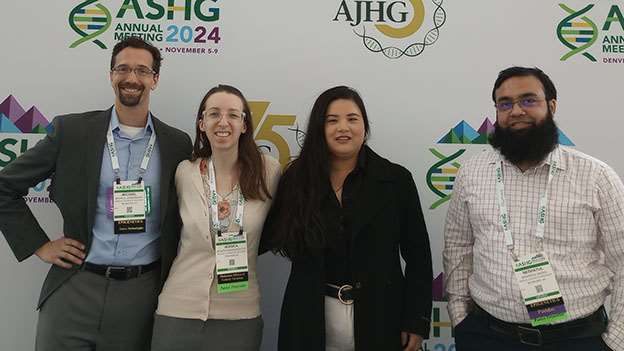Zimmerman Laboratory
Location
HRC5 - Mellowes Center

Interests
- Human genetic diseases of the epigenome
- Mechanistic interpretation of inter-individual genetic variation using protein structural models
- Rare disease discovery and diagnosis via enhanced computational approaches
- Scaling our approaches developed for heritable genetic diseases, to populations and their many one-of-a-kind variations
- Integrative modeling to bridge across multiple experiments and derive highly dynamic models of protein complex’s function
- Multi-omics data as functional readouts of chromatin regulating enzymes
Computational Structural Genomics: A Transformational Approach for Biology and Medicine
Quantifying Disparate Molecular Mechanisms Underlying the Effects of Numerous Variants of Uncertain Significance
Scaling Genomic Data Interpretation to Complexes, Super-Complexes, and Beyond
Quantifying the Domain-Type-Level Flexibilities that Need to be Accounted for Computational Structural Genomics
Piloting protein surface-based scores for interpreting the effects of genetic variants at distant functional sites
Mechanisms of the BAF Chromatin Remodeling Complex
RAG Complex Modeling for Rare Diseases
Our Current Members

Michael T. Zimmermann, PhD
Director, Computational Structural Genomics Unit and Associate Director, Computational Biology, Linda T. and John A. Mellowes Center for Genomic Sciences and Precision Medicine; Associate Professor, Data Science Institute

Xiaowei Dong
PhD Student

Rebekah J. Fogarty, MS
Bioinformatics Analyst I

Jane Gresser, MS
Bioinformatics Analyst I

Neshatul Haque, PhD
Postdoctoral Researcher

Jessica Wagenknecht, PhD
Bioinformatics Analyst II
Recent Publications
-
Discovery of a MET -driven monogenic cause of steatotic liver disease.
(Pinto E Vairo F, Zimmermann MT, Wagenknecht J, Jorge SD, Tian S, Vierkant RA, Luehrs AC, Milech de Assunção T, Mathison A, Atwal PS, Cao Y, Allen AM, Klee EW, Urrutia R, Lazaridis KN.) Hepatology. 2025 Dec 01;82(6):1512-1522 PMID: 39879586 SCOPUS ID: 2-s2.0-85217105777 01/29/2025
-
(Veluri R, Pollin G, Wagenknecht JB, Urrutia R, Zimmermann MT.) bioRxiv. 2025 Feb 05 PMID: 39974886 PMCID: PMC11838408 02/20/2025
-
Hypomorphic RAG2 Deficiency Promotes Selection of Self-Reactive B Cells.
(Thouvenel CD, Tipton CM, Yamazaki Y, Zhang TT, Rylaarsdam S, Hom JR, Snead C, Zhu C, Li QZ, Lee YN, Kawai T, Haque N, Zimmermann MT, Ponnan SM, Jackson SW, James RG, Sanz I, Notarangelo LD, Torgerson TR, Ochs HD, Rawlings DJ, Allenspach EJ.) J Clin Immunol. 2025 Jan 15;45(1):66 PMID: 39812873 PMCID: PMC11735530 SCOPUS ID: 2-s2.0-85217272111 01/15/2025
-
(Dong J, Zimmermann MT, Haque N, Arsang-Jang S, Saber W, Gai X, Urrutia R.) Transplantation Reports. February 2025;10(1) SCOPUS ID: 2-s2.0-85215105221 02/01/2025
-
(DeVoe E, Reddi HV, Taylor BW, Stachowiak S, Geurts JL, George B, Shaker R, Urrutia R, Zimmermann MT.) J Comput Biol. 2025 Jan;32(1):89-103 PMID: 39659251 PMCID: PMC11839515 SCOPUS ID: 2-s2.0-85215145104 12/11/2024
-
(Pollin G, Chi YI, Mathison AJ, Zimmermann MT, Lomberk G, Urrutia R.) Epigenomics. 2025 Jan;17(1):5-20 PMID: 39632680 PMCID: PMC11703355 SCOPUS ID: 2-s2.0-85210974733 12/05/2024
-
Assessing Protein Surface-Based Scoring for Interpreting Genomic Variants.
(Dsouza NR, Haque N, Tripathi S, Zimmermann MT.) Int J Mol Sci. 2024 Nov 08;25(22) PMID: 39596086 PMCID: PMC11594063 SCOPUS ID: 2-s2.0-85210224251 11/27/2024
-
(Gong M, Li J, Qin Z, Machado Bressan Wilke MV, Liu Y, Li Q, Liu H, Liang C, Morales-Rosado JA, Cohen ASA, Hughes SS, Sullivan BR, Waddell V, van den Boogaard MH, van Jaarsveld RH, van Binsbergen E, van Gassen KL, Wang T, Hiatt SM, Amaral MD, Kelley WV, Zhao J, Feng W, Ren C, Yu Y, Boczek NJ, Ferber MJ, Lahner C, Elliott S, Ruan Y, Mignot C, Keren B, Xie H, Wang X, Popp B, Zweier C, Piard J, Coubes C, Mau-Them FT, Safraou H, Innes AM, Gauthier J, Michaud JL, Koboldt DC, Sylvie O, Willems M, Tan WH, Cogne B, Rieubland C, Braun D, McLean SD, Platzer K, Zacher P, Oppermann H, Evenepoel L, Blanc P, El Khattabi L, Haque N, Dsouza NR, Zimmermann MT, Urrutia R, Klee EW, Shen Y, Du H, Rappaport L, Liu CM, Chen X.) Am J Hum Genet. 2024 Nov 07;111(11):2392-2410 PMID: 39419027 PMCID: PMC11568763 SCOPUS ID: 2-s2.0-85207372821 10/18/2024
-
(Hall WA, Mathison AJ, DeVoe E, Tschannen M, Wendt-Andrae J, Straza M, Awan M, Puckett LL, Lawton CAF, Schultz C, Urrutia R, Kerns S, Torres-Roca JF, Li XA, Erickson B, Nevalainen MT, Zimmermann MT, Paulson E.) Int J Radiat Oncol Biol Phys. 2024 Oct 01;120(2):570-578 PMID: 38819340 SCOPUS ID: 2-s2.0-85194948255 05/31/2024
-
Mutant KRAS inhibitors enter the scene of precision therapeutics for pancreatic cancer.
(Pollin G, Lomberk GA, Mathison AJ, Zimmermann MT, Urrutia R.) J Gastrointest Oncol. 2024 Aug 31;15(4):1996-2001 PMID: 39279937 PMCID: PMC11399826 09/16/2024
-
(Kim J, Zimmermann MT, Mathison AJ, Lomberk G, Urrutia R, Hong JC.) Ann Surg Open. 2024 Jun;5(2):e444 PMID: 38911661 PMCID: PMC11191965 06/24/2024
-
Type I interferon signaling promotes radioresistance in head and neck cancer.
(Zenga J, Awan MJ, Frei A, Massey B, Bruening J, Shukla M, Sharma GP, Shreenivas A, Wong SJ, Zimmermann MT, Mathison AJ, Himburg HA.) Transl Cancer Res. 2024 May 31;13(5):2535-2543 PMID: 38881922 PMCID: PMC11170510 06/17/2024
-
(Bursch KL, Goetz CJ, Jiao G, Nuñez R, Olp MD, Dhiman A, Khurana M, Zimmermann MT, Urrutia RA, Dykhuizen EC, Smith BC.) J Biol Chem. 2024 Apr;300(4):107146 PMID: 38460939 PMCID: PMC11002309 SCOPUS ID: 2-s2.0-85189184192 03/10/2024
-
(Dsouza NR, Cottrell CE, Davies OMT, Tollefson MM, Frieden IJ, Basel D, Urrutia R, Drolet BA, Zimmermann MT.) Life (Basel). 2024 Feb 23;14(3) PMID: 38541623 PMCID: PMC10971029 SCOPUS ID: 2-s2.0-85193266612 03/28/2024
-
(Haque N, Wagenknecht JB, Ratnasinghe BD, Zimmermann MT.) PLoS One. 2024;19(11):e0313308 PMID: 39591473 PMCID: PMC11594405 SCOPUS ID: 2-s2.0-85210375728 11/26/2024
-
Assessing Protein Surface-Based Scoring for Interpreting Genomic Variants
(Dsouza NR, Haque N, Tripathi S, Zimmermann MT.) International Journal of Molecular Sciences. November 2024;25(22) SCOPUS ID: 2-s2.0-85210224251 11/01/2024
-
Mutant KRAS inhibitors enter the scene of precision therapeutics for pancreatic cancer
(Pollin G, Lomberk GA, Mathison AJ, Zimmermann MT, Urrutia R.) Journal of Gastrointestinal Oncology. 31 August 2024;15(4):1996-2001 SCOPUS ID: 2-s2.0-85203321495 08/31/2024
-
(Pollin G, Mathison AJ, de Assuncao TM, Thomas A, Zeighami A, Salmonson A, Liu H, Urrutia G, Vankayala P, Pandol SJ, Hong JC, Zimmermann MT, Iovanna J, Jin VX, Urrutia R, Lomberk G.) Front Genet. 2024;15:1412767 PMID: 38948355 PMCID: PMC11211573 SCOPUS ID: 2-s2.0-85197408751 07/01/2024
-
Type I interferon signaling promotes radioresistance in head and neck cancer
(Zenga J, Awan MJ, Frei A, Massey B, Bruening J, Shukla M, Sharma GP, Shreenivas A, Wong SJ, Zimmermann MT, Mathison AJ, Himburg HA.) Translational Cancer Research. 2024;13(5):2535-2543 SCOPUS ID: 2-s2.0-85195040296 01/01/2024
-
IL6Myc mouse is an immunocompetent model for the development of aggressive multiple myeloma.
(Pisano MD, Sun F, Cheng Y, Parashar D, Zhou V, Jing X, Sompallae R, Abrudan J, Zimmermann MT, Mathison A, Janz S, Pufall MA.) Haematologica. 2023 Dec 01;108(12):3372-3383 PMID: 37439384 PMCID: PMC10690922 SCOPUS ID: 2-s2.0-85178652041 07/13/2023
-
(Pollin G, De Assuncao TM, Doria Jorge S, Chi YI, Charlesworth MC, Madden B, Iovanna J, Zimmermann MT, Urrutia R, Lomberk G.) Biosci Rep. 2023 Oct 31;43(10) PMID: 37782747 PMCID: PMC10611923 SCOPUS ID: 2-s2.0-85175273435 10/02/2023
-
(Haque N, Kawai T, Ratnasinghe BD, Wagenknecht JB, Urrutia R, Notarangelo LD, Zimmermann MT.) iScience. 2023 Oct 20;26(10):108040 PMID: 37854700 PMCID: PMC10579426 10/19/2023
-
(Jorge SD, Chi YI, Mazaba JL, Haque N, Wagenknecht J, Smith BC, Volkman BF, Mathison AJ, Lomberk G, Zimmermann MT, Urrutia R.) Front Genet. 2023;14:1291307 PMID: 38090150 PMCID: PMC10715303 SCOPUS ID: 2-s2.0-85179362461 12/13/2023
-
(Chi YI, Jorge SD, Jensen DR, Smith BC, Volkman BF, Mathison AJ, Lomberk G, Zimmermann MT, Urrutia R.) Comput Struct Biotechnol J. 2023;21:5249-5258 PMID: 37954151 PMCID: PMC10632586 11/13/2023
-
(Ratnasinghe BD, Haque N, Wagenknecht JB, Jensen DR, Valdivia Esparza GK, Leverence EN, Milech De Assuncao T, Mathison AJ, Lomberk G, Smith BC, Volkman BF, Urrutia R, Zimmermann MT.) Comput Struct Biotechnol J. 2023;21:4790-4803 PMID: 37841325 PMCID: PMC10570560 10/16/2023






